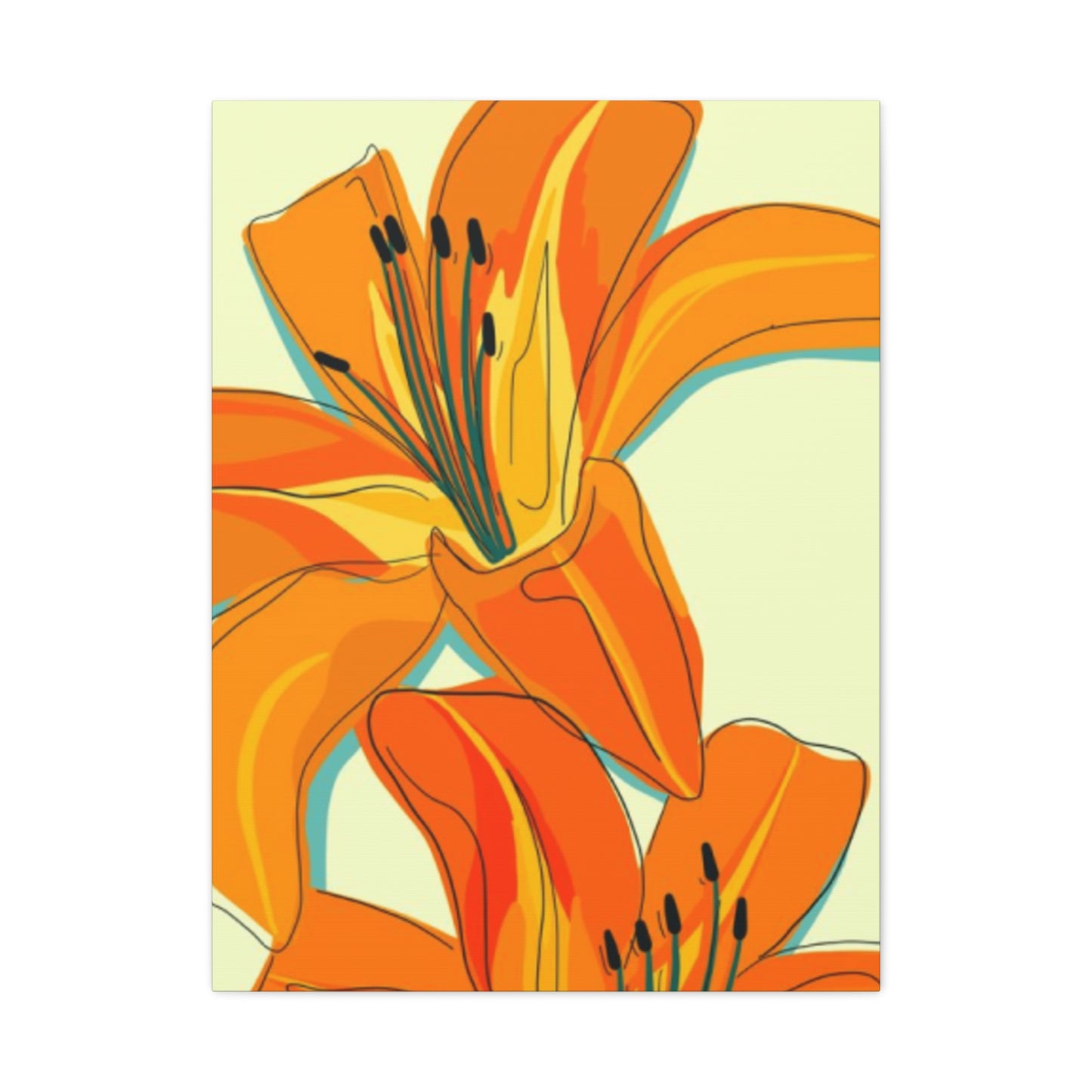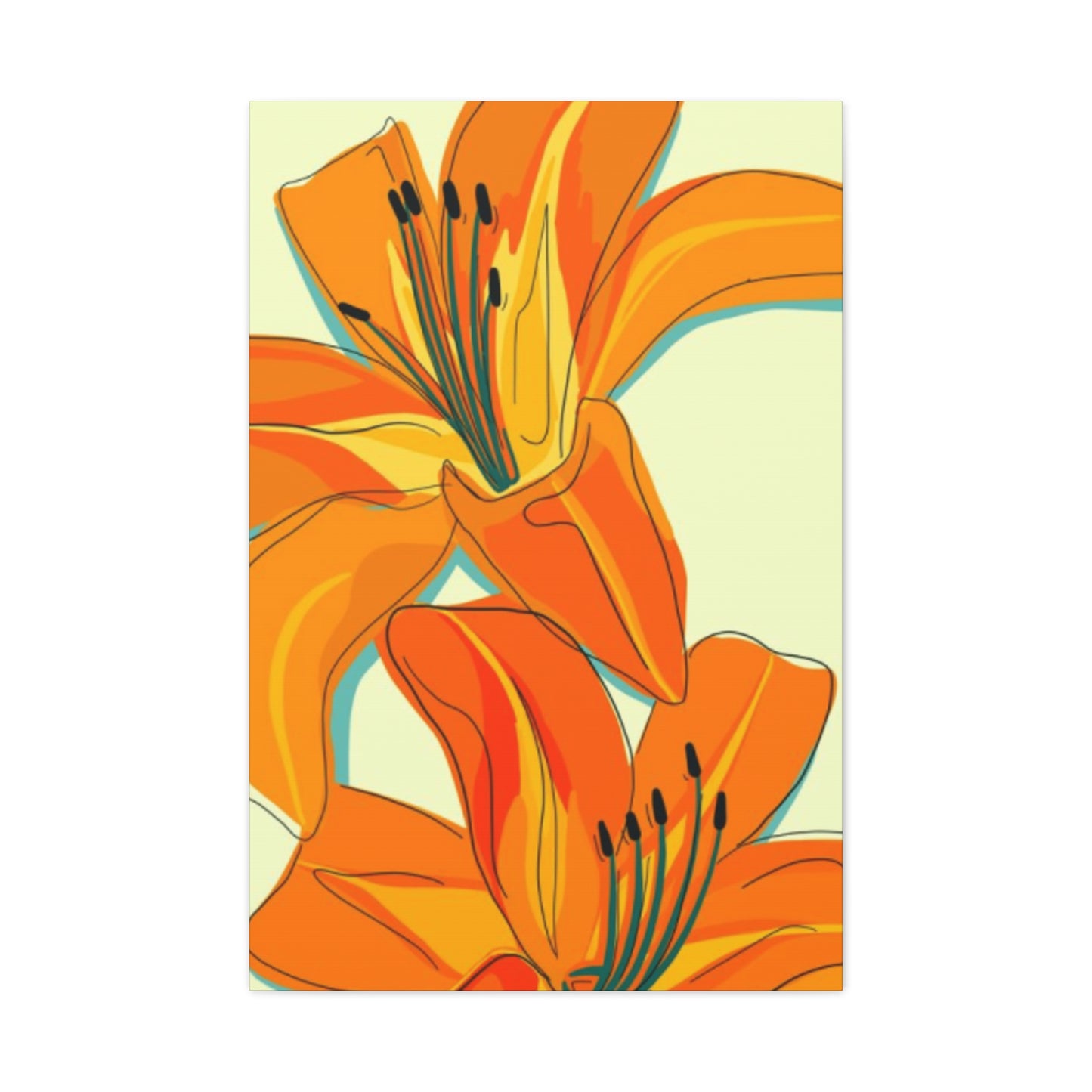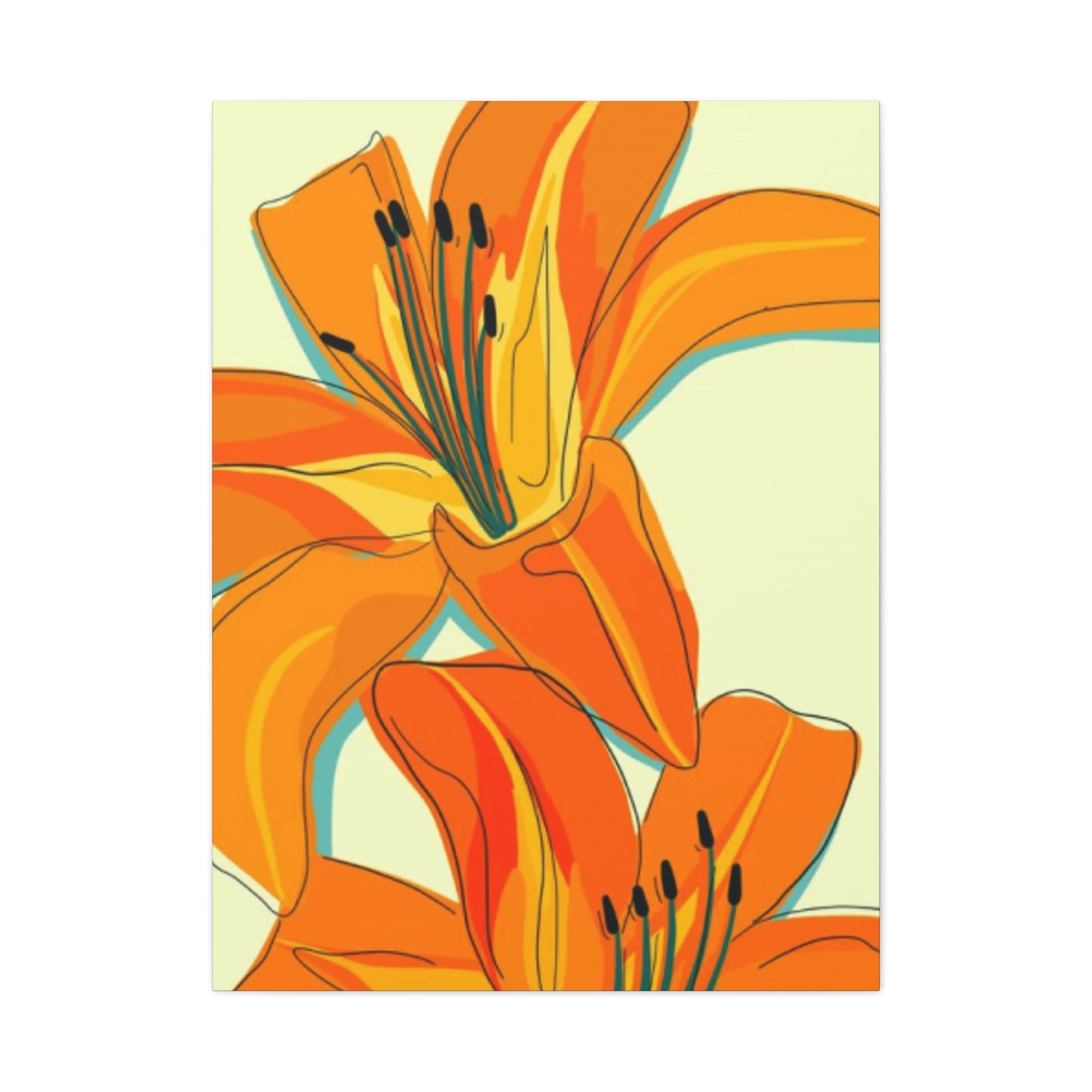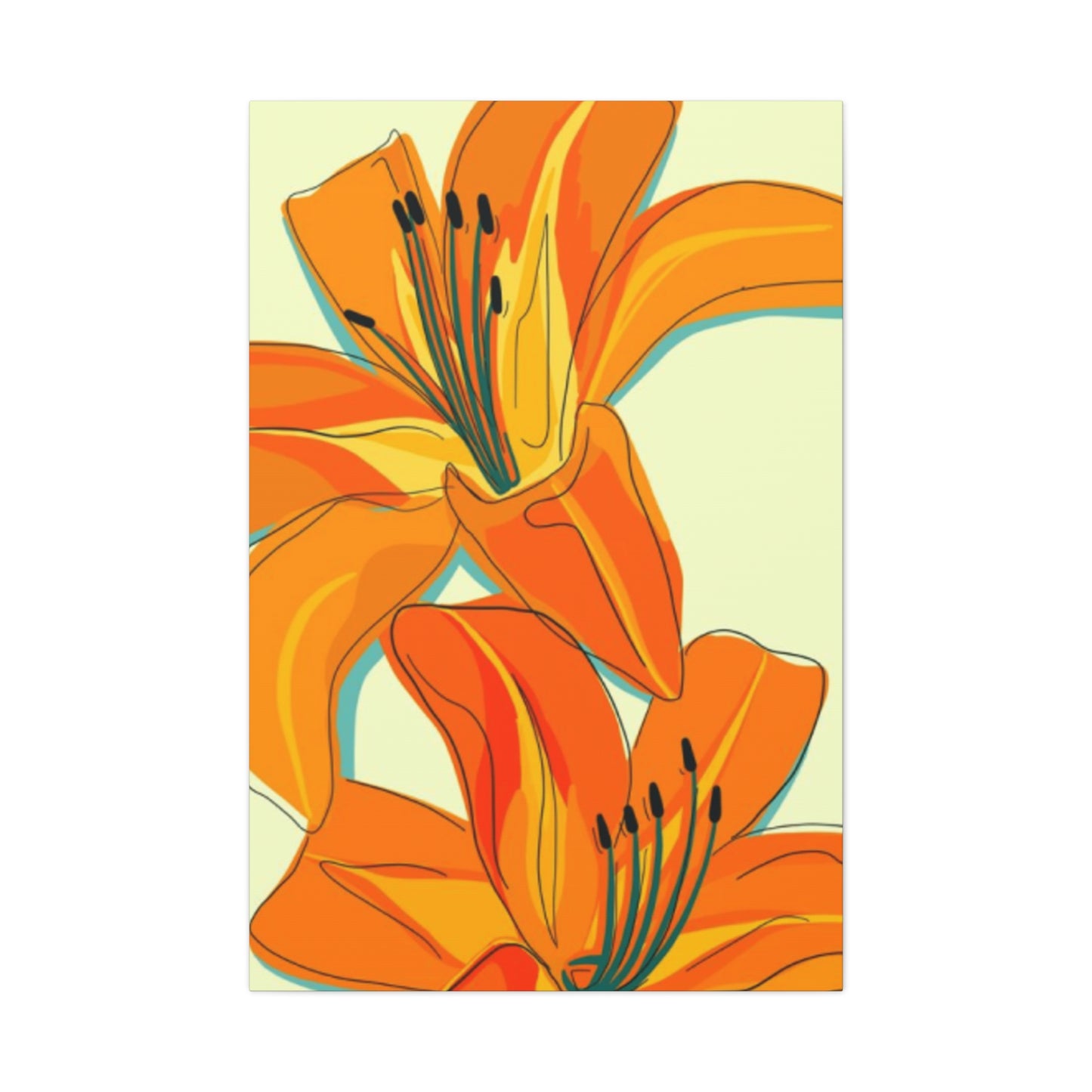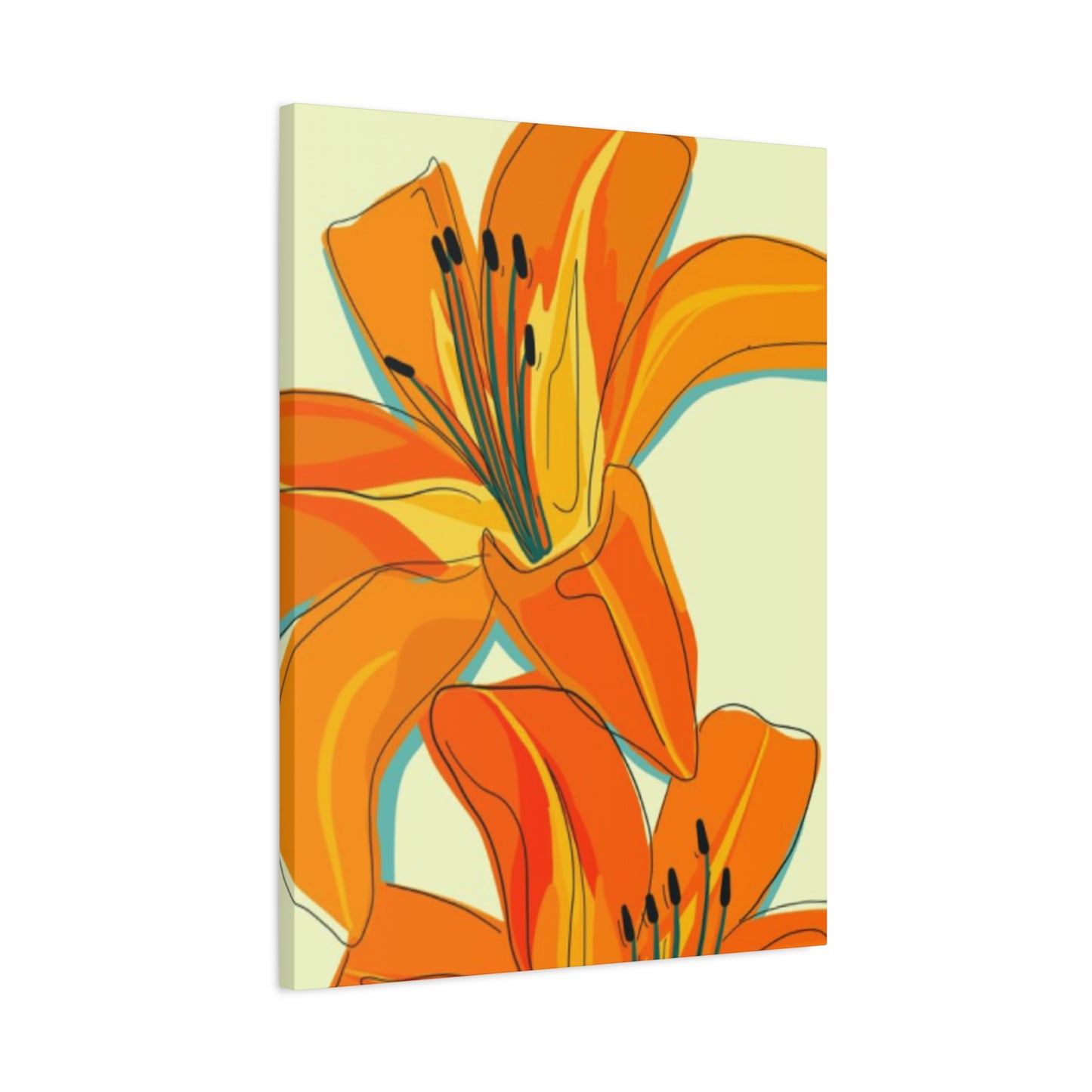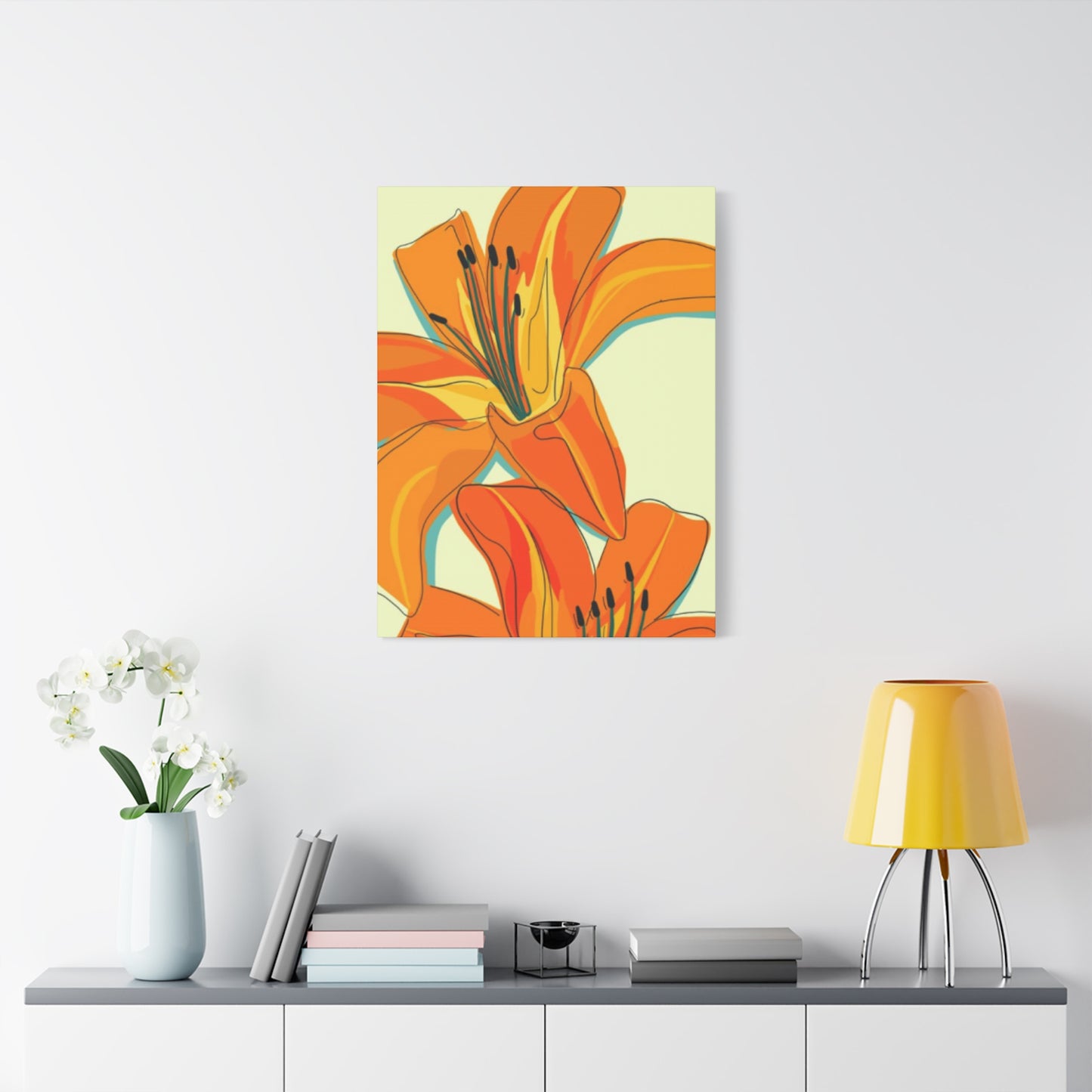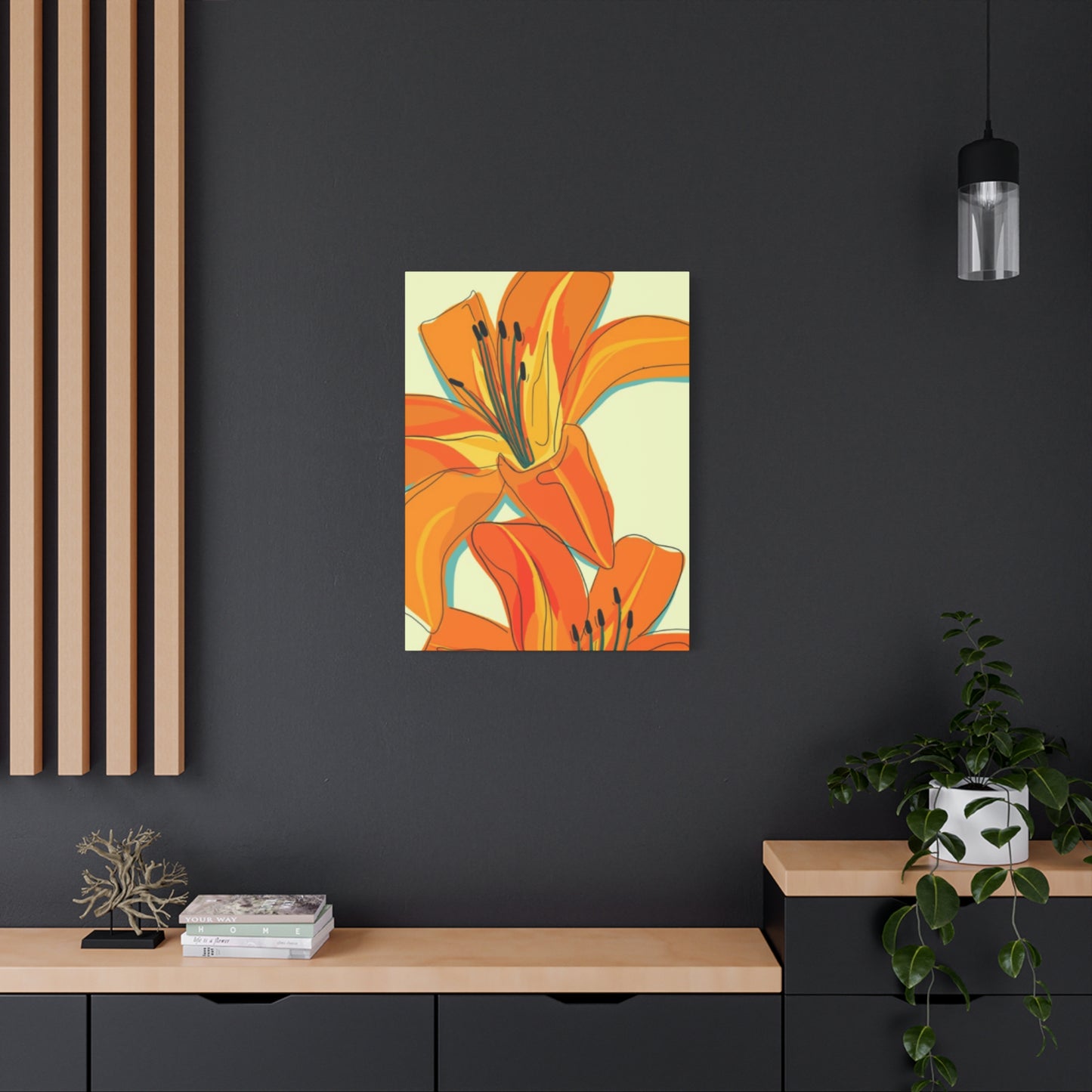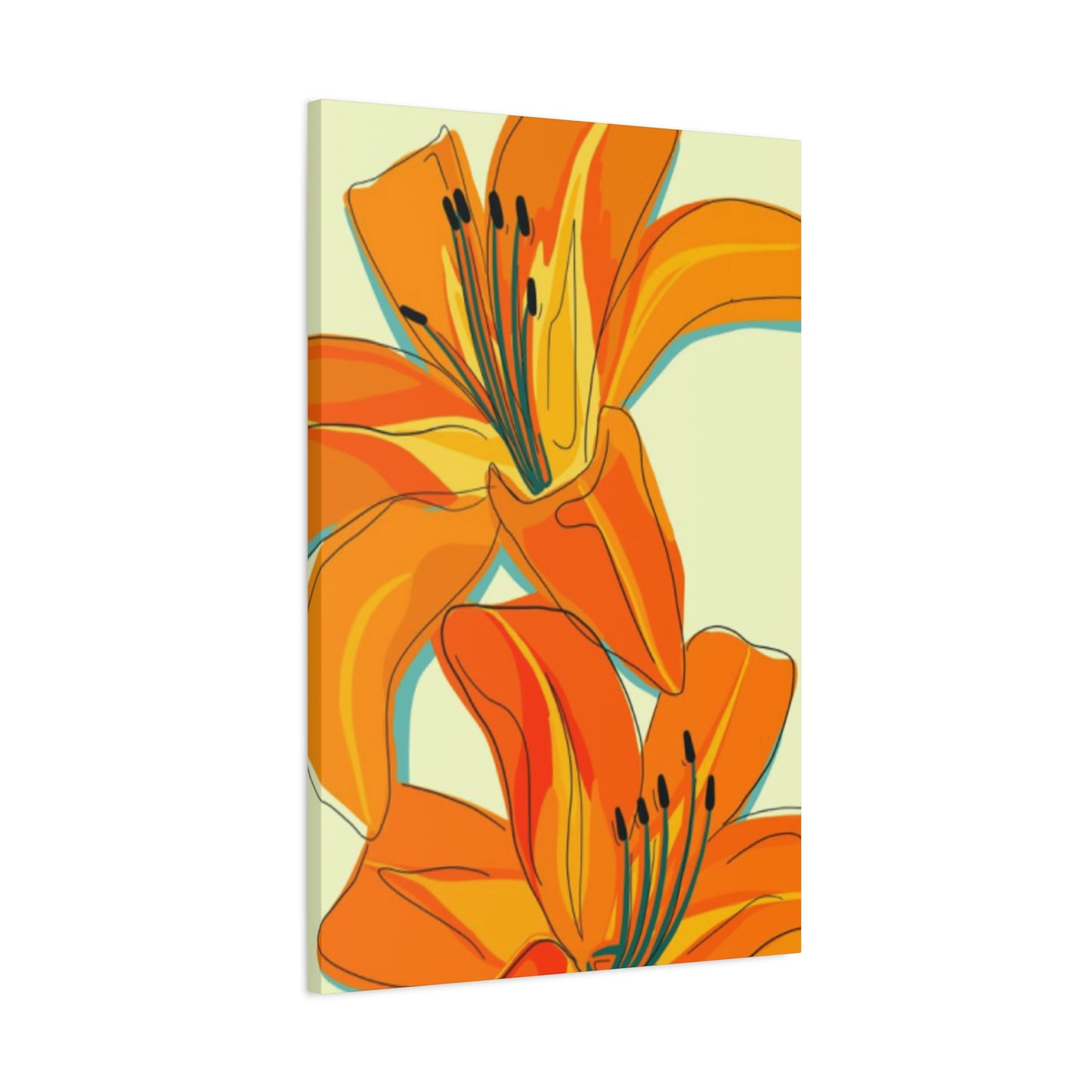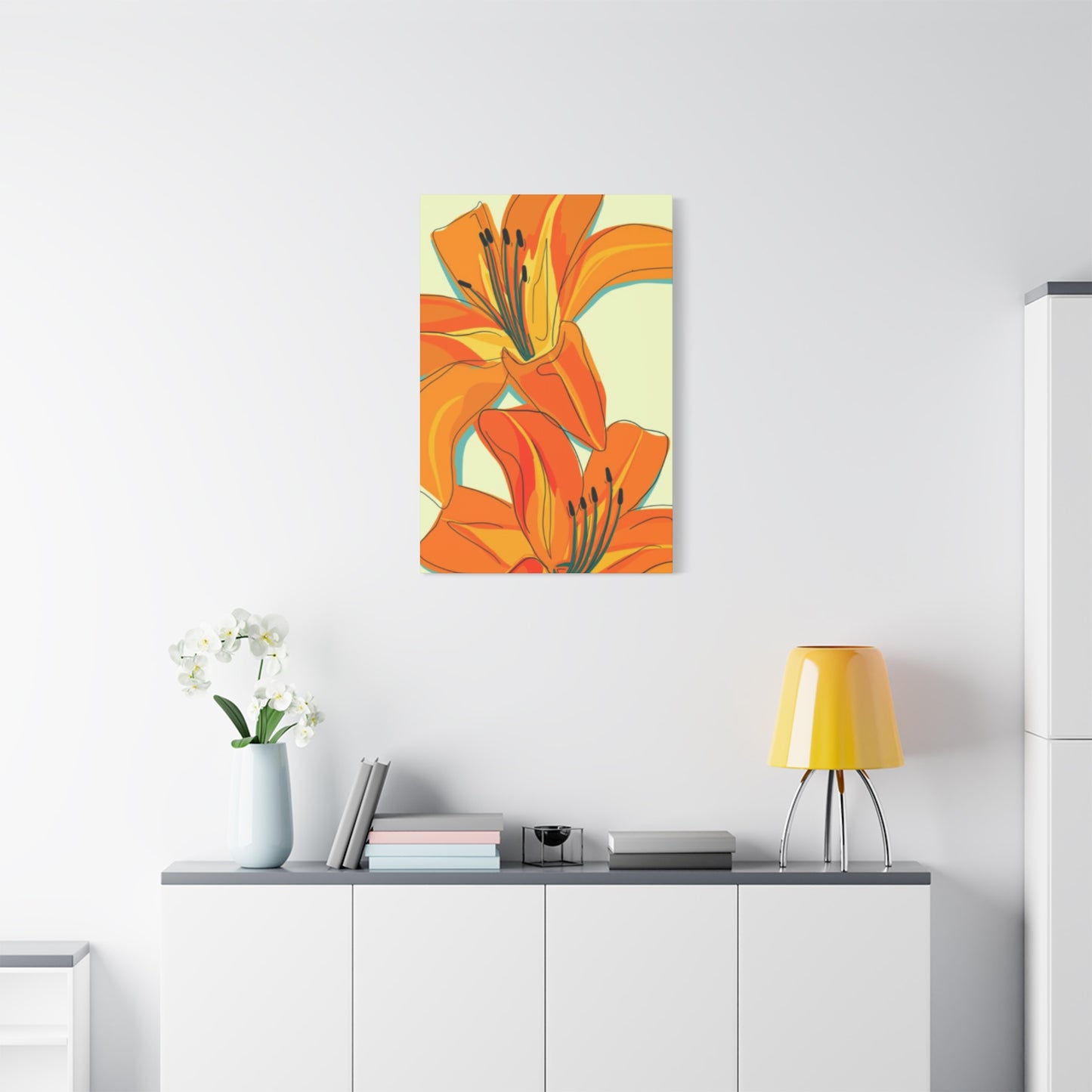A Splash of Radiance: Elevating Your Home with Orange Flower Wall Art
The decision to introduce art into a living space is a defining moment in the journey of creating a home. It is a choice that infuses personality, emotion, and a distinct aesthetic into the very walls that shelter us. Among the vast universe of artistic expressions, botanical art holds a special, timeless appeal, connecting our modern interiors with the enduring beauty of the natural world. Within this category, a particularly vibrant and evocative choice is orange flower wall art. This specific genre of decor does more than simply add a splash of color; it introduces a dynamic energy, a sense of warmth, and a sophisticated charm that can redefine a room's atmosphere.
The color orange itself is a complex and powerful hue, sitting at the intersection of red's passion and yellow's cheerfulness. When applied to the delicate and intricate forms of flowers, it creates a visual experience that is both invigorating and comforting. Whether it is the soft, peachy blush of a rose, the fiery intensity of a poppy, or the cheerful glow of a marigold, orange floral artwork captures a spectrum of moods that can cater to any design vision. This exploration delves deep into the world of orange flower wall art, examining its profound impact on interior design, its symbolic richness, and the practical considerations for integrating this luminous art form into your home to create a space that is not just decorated, but truly alive.
The Luminous Appeal of Orange Floral Decor
There is an undeniable magnetic quality to orange flower wall art that captivates the eye and enlivens the spirit. This allure stems from a powerful combination of color psychology and the inherent beauty of botanical subjects. Orange is the color of sunsets, of autumn leaves, and of crackling fires; it is intrinsically linked to warmth, energy, and optimism. When this vibrant hue is channeled through the graceful petals of a flower, it creates a piece of art that radiates positivity. Unlike more subdued palettes, orange floral decor refuses to be a passive background element. It actively engages with the viewer, drawing them in and infusing the surrounding space with a dynamic sense of vitality.
This makes it an exceptionally powerful tool for any homeowner or designer looking to combat monotony or breathe life into a forgotten corner. The luminous appeal also lies in its versatility. A soft apricot or peach-toned floral print can evoke a sense of gentle romance and serene warmth, perfect for a tranquil bedroom. In contrast, a bold, electric tangerine or burnt sienna can create a dramatic focal point in a living room or entryway, sparking conversation and showcasing a confident design sensibility. The subject matter itself—the flower—adds another layer of appeal, representing growth, beauty, and the cycles of nature. This combination of an energizing color with a symbol of natural elegance makes orange flower wall art a uniquely compelling choice for transforming a house into a vibrant, welcoming home.
Exploring the Spectrum of Orange in Botanical Art
The term "orange" encompasses a vast and nuanced spectrum of shades, each carrying its own distinct personality and emotional resonance. When selecting orange flower wall art, understanding this spectrum is key to achieving the desired atmosphere in your space. The range begins with the softest, most delicate hues like peach and apricot. These colors are imbued with a gentle, romantic warmth, often associated with subtlety and sophistication. An artwork featuring peach-toned roses or pale apricot lilies can bring a soft glow to a room, creating a serene and inviting ambiance without overwhelming the existing decor. Moving along the spectrum, we encounter the brighter, more cheerful shades like tangerine and marigold. These are colors bursting with energy, joy, and optimism.
A canvas print of vibrant orange marigolds or a cheerful cluster of gerbera daisies can act as an instant mood-lifter, perfect for social spaces like kitchens and dining areas where lively conversation is encouraged. As the spectrum deepens, we find the richer, more intense shades of burnt orange, terracotta, and rust. These earthy tones are grounding and comforting, evoking the feeling of autumnal landscapes and cozy hearths. Orange flower wall art in these hues, perhaps depicting dahlias or chrysanthemums, can add a layer of sophisticated warmth and rustic elegance to a study, library, or living room, making the space feel anchored and intimate. The fiery end of the spectrum includes shades like vermilion and crimson-orange, which are bold, passionate, and dramatic. An art piece featuring a single, brilliant orange poppy in one of these powerful shades can serve as a stunning, high-impact focal point, conveying confidence and artistic flair.
Symbolism and Meaning Behind Orange Blossoms in Decor
Beyond their aesthetic beauty, the flowers depicted in orange flower wall art carry rich layers of symbolism and meaning that can add depth and personal significance to your home decor. The color orange itself is universally associated with enthusiasm, creativity, and determination. It is a hue that encourages social interaction and radiates a positive, uplifting energy. When this symbolic color is combined with the specific meanings of different flowers, the resulting artwork becomes a powerful narrative piece. For instance, the marigold, a frequent subject in orange floral art, is a symbol of passion, creativity, and the warmth of the rising sun in many cultures. Hanging an artwork of marigolds can be a way to invite positive energy and a celebration of life into your home.
Similarly, orange lilies are often associated with confidence, honor, and wealth. A tasteful print of elegant orange lilies in an entryway or home office can project a sense of ambition and pride. The zinnia, with its vibrant, multi-petaled form, symbolizes endurance and lasting affection, making a piece of zinnia art a wonderful addition to a family room or a thoughtful gift for a loved one. Even the common poppy, when rendered in a brilliant orange, can represent imagination and a sense of remembrance. By choosing a piece of orange flower wall art, you are not just selecting a color and a shape; you are embracing a story. This thoughtful approach to decoration transforms your walls from mere partitions into a canvas for personal expression, allowing you to curate an environment that reflects your values, aspirations, and the emotions you wish to cultivate within your personal sanctuary.
Choosing the Right Orange Flower for Your Artwork
The specific type of flower featured in your orange flower wall art plays a pivotal role in defining the piece's overall style and mood. Each bloom possesses a unique structure, texture, and character that an artist can interpret in countless ways. Making a deliberate choice about the flower itself allows you to tailor the artwork precisely to your aesthetic preferences and the atmosphere you wish to create. For a look of classic elegance and romance, consider artwork that features orange roses or tulips. The soft, layered petals of a rose can convey a sense of gentle sophistication, while the sleek, graceful form of a tulip adds a touch of modern refinement. These flowers work exceptionally well in more traditional or transitional design schemes. If you are aiming for a more bold and dramatic statement, poppies are an excellent choice.
Their delicate, paper-thin petals and vibrant, often fiery orange hues create a high-contrast image that is both passionate and artistically striking. An oversized canvas of a single orange poppy can become the undisputed focal point of any room. For those who prefer a more cheerful, rustic, or bohemian vibe, flowers like marigolds, zinnias, and sunflowers are ideal. Their full, sun-facing blossoms and rich, warm oranges evoke feelings of happiness, abundance, and a connection to nature. This type of orange flower wall art is perfect for kitchens, sunrooms, or any space where a joyful and welcoming atmosphere is desired. Finally, for a touch of the exotic and sophisticated, consider artworks depicting orange lilies or birds of paradise. The intricate shapes and bold forms of these tropical flowers add a layer of intrigue and worldliness to your decor, making them a superb choice for a contemporary or eclectic interior.
Marigolds in Wall Art: A Touch of Sunshine and Celebration
Marigolds are one of the most beloved subjects for orange flower wall art, and for good reason. Their dense, ruffled petals and intensely saturated golden-orange color make them a symbol of sunshine, joy, and celebration. An art piece centered on marigolds is never just a passive decoration; it is an active infusion of warmth and positive energy into a space. The visual texture of a marigold is particularly captivating in art. Whether rendered in a detailed photograph that captures every delicate fold of its petals or in a painterly style that emphasizes its vibrant color, the marigold's form is inherently cheerful and robust. This makes it an incredibly versatile flower for various decor styles. In a rustic or farmhouse-inspired home, a print of marigolds in a simple wooden frame can enhance the cozy, back-to-nature aesthetic.
In a more eclectic or bohemian space, a large, vibrant canvas of marigolds can serve as a joyful anchor piece, tying together other colorful elements in the room. Beyond their visual appeal, marigolds are rich in cultural significance, often associated with festivals, ceremonies, and the sun's life-giving power in many parts of the world. Incorporating marigold wall art can thus add a layer of global sophistication and meaningful storytelling to your interior design. It becomes a nod to tradition and a celebration of life's brightest moments. Placing a piece of orange flower wall art featuring marigolds in a dining room can stimulate appetite and conversation, while hanging it in a dimly lit hallway can bring a surprising and welcome burst of light and energy, transforming a purely functional area into a delightful experience.
The Fiery Passion of Orange Poppies on Canvas
When the goal is to create a powerful and unforgettable artistic statement, orange flower wall art featuring poppies is an unparalleled choice. The poppy is a flower of beautiful contradictions; its petals are incredibly delicate and almost translucent, yet its color is often a fiery, intense orange that commands immediate attention. This duality makes it a fascinating subject for artists and a captivating element in interior design. A large-scale canvas print of a single, vibrant orange poppy can transform a wall into a gallery-worthy focal point. The sheer force of its color against a neutral background creates a dramatic visual impact that speaks of confidence, passion, and artistic sensibility. This type of artwork is particularly effective in minimalist or contemporary spaces, where its singular beauty can be appreciated without distraction.
The symbolism of the poppy adds another layer of depth. While red poppies are famously associated with remembrance, the orange poppy is often linked to imagination, creativity, and the pursuit of pleasure. Hanging orange poppy art can be an expression of a creative spirit and a desire to live life vividly. The form of the poppy also lends itself to various artistic interpretations. An impressionistic painting might capture the way light filters through its thin petals, creating a soft, dreamy effect. A hyper-realistic photograph could focus on the intricate details of its dark center and the subtle veins on its petals. An abstract piece might deconstruct the poppy's form into a swirl of passionate color and energy. Regardless of the style, orange poppy wall art is a choice for those who are unafraid of color and wish to infuse their living space with a sense of fiery passion and dynamic energy.
Zinnias and Dahlias: The Geometric Beauty of Orange Florals
The world of orange flower wall art offers stunning options for those who appreciate pattern, structure, and intricate detail in the form of zinnias and dahlias. These flowers are nature's geometers, boasting a mesmerizing arrangement of petals that radiate from a central point, creating a visual effect that is both complex and perfectly orderly. An artwork that focuses on an orange zinnia or dahlia is a celebration of this natural symmetry and can add a unique, almost architectural element to your decor. Dahlias, in particular, are famous for their "Fibonacci spiral" petal arrangements, which are inherently pleasing to the human eye. A large, close-up canvas of an orange dahlia can act as a hypnotic mandala, drawing the viewer in and providing a point of focus and contemplation.
This makes such pieces ideal for spaces intended for relaxation and calm, like a reading nook or a bedroom. Zinnias, with their cheerful, daisy-like appearance and densely packed petals, offer a similar geometric appeal but with a more playful and vibrant energy. A piece of wall art featuring a field of orange zinnias can create a sense of joyful abundance and visual rhythm. These flowers are particularly well-suited for modern, mid-century, or even art deco-inspired interiors, where geometric patterns and clean lines are celebrated. The beauty of choosing orange zinnia or dahlia art is that it satisfies both the love for botanical subjects and the appreciation for abstract pattern, bridging the gap between the natural world and structured design. It is a sophisticated choice that adds layers of visual interest and intellectual appeal to any wall.
Abstract Interpretations of Orange Flower Wall Art
For the modern art enthusiast, abstract orange flower wall art offers a way to embrace the energy and warmth of the floral theme without being tied to literal representation. This style of art distills the essence of a flower—its color, its form, its energy—down to its most basic components of shape, line, and hue. The result is a piece that is evocative and emotionally resonant, inviting personal interpretation from the viewer. An abstract piece might use bold, sweeping strokes of burnt orange and tangerine to suggest the explosive burst of a blooming flower. Another might use a more subtle approach, with soft, blended washes of peach and coral to capture the feeling of a sun-drenched garden.
This departure from realism allows the color orange to take center stage, showcasing its full emotional range from vibrant joy to deep, contemplative warmth. Abstract orange floral art is incredibly versatile and can seamlessly integrate into contemporary, minimalist, and eclectic interiors. It can serve as a powerful pop of color in a monochromatic room or act as a unifying element that ties together other colors in a more complex palette. Because it is not a direct depiction of a specific flower, it has a timeless quality that will not easily fall out of fashion. Choosing an abstract interpretation is a sophisticated design move that demonstrates an appreciation for art as a form of emotional expression. It allows you to introduce the organic, life-affirming energy of flowers into your home in a way that feels fresh, modern, and uniquely personal.
Impressionistic Orange Flower Art: Capturing Light and Emotion
Impressionistic orange flower wall art provides a beautiful middle ground between literal representation and pure abstraction. Inspired by the 19th-century art movement, this style is less concerned with capturing the precise details of a flower and more focused on capturing the fleeting impression of light, color, and atmosphere. The artist uses visible brushstrokes, a vibrant palette, and an emphasis on the changing qualities of light to create a piece that is dynamic, emotive, and full of life. An impressionistic painting of an orange flower garden, for example, might not show you every single petal and leaf, but it will make you feel the warmth of the afternoon sun and the gentle sway of the blossoms in the breeze.
The use of color is often non-naturalistic, with strokes of yellow, red, and even blue mixed in with the orange to convey the way light reflects and refracts. This technique gives the artwork a shimmering, vibrant quality that can make a room feel more alive and energetic. This style is perfect for those who appreciate classic art but want a piece that feels fresh and expressive. It pairs beautifully with both traditional and transitional decor, adding a touch of artistic sophistication and a sense of history. Impressionistic orange flower art invites the viewer to step back and take in the overall feeling of the scene, making it a wonderful conversation piece. It is a choice that celebrates not just the flower itself, but the artist's emotional response to its beauty, allowing that captured moment of light and feeling to radiate throughout your home.
Modern and Minimalist Approaches to Orange Floral Decor
In the realm of contemporary interior design, modern and minimalist approaches to orange flower wall art offer a chic and refined way to incorporate botanical beauty. This style strips the subject down to its essential elements, focusing on clean lines, simple forms, and a deliberate use of negative space. The result is an artwork that is powerful in its simplicity and makes a sophisticated statement without creating visual clutter. A minimalist piece might feature a single, stylized orange flower, rendered in a solid block of color against a crisp white or grey background. The focus here is on the purity of the form and the impact of the color. Another modern approach could be a simple, elegant line drawing of an orange blossom, where the artist's skillful use of a single continuous line defines the entire shape.
This type of art is perfect for Scandinavian, Japanese-inspired, or minimalist interiors where the philosophy of "less is more" prevails. It adds a touch of organic softness to rooms dominated by hard surfaces and neutral tones, preventing the space from feeling cold or sterile. Modern orange floral decor often plays with scale, with oversized prints of a single flower detail—like the curve of a petal or the structure of a stamen—being a popular choice. This close-up perspective turns the natural object into a piece of graphic design, celebrating its inherent patterns and textures. Choosing a modern or minimalist piece of orange flower wall art is a testament to a curated and uncluttered aesthetic, proving that a single, well-chosen element can have a more profound impact than a multitude of smaller decorations.
Photographic Orange Flower Wall Art: Hyper-Realism and Detail
For those who marvel at the intricate perfection of the natural world, photographic orange flower wall art offers an unparalleled level of detail and realism. High-resolution photography can capture the subtle nuances of a flower that other mediums can only suggest. From the velvety texture of a rose petal to the delicate dusting of pollen on a lily's stamen, a photographic print brings the subject to life with breathtaking clarity. This style of art allows you to appreciate the flower as a masterpiece of natural engineering. Macro photography, in particular, can transform a familiar bloom into an abstract landscape of color and texture, revealing a hidden world of beauty.
A large-scale macro photograph of an orange gerbera daisy, for example, can become a stunning, almost surreal focal point, its radial symmetry and vibrant color creating a mesmerizing effect. Hyper-realistic photography is also a powerful tool for creating a sense of tranquility and connection to nature. A photo of orange blossoms dotted with morning dew can bring a feeling of fresh, serene mornings into a bedroom or bathroom. A shot of a sun-drenched field of orange California poppies can evoke a sense of open space and freedom in a living room. This style of orange flower wall art is incredibly versatile, fitting well within modern, contemporary, and even traditional decor schemes. It acts as a window to the outdoors, reminding us of the intricate beauty that surrounds us and bringing a piece of that living, breathing world into our homes.
Framed vs. Unframed Orange Flower Wall Art
The decision to frame your orange flower wall art or to leave it unframed is a significant stylistic choice that can dramatically alter its impact on your space. An unframed piece, such as a gallery-wrapped canvas, offers a clean, modern, and minimalist aesthetic. By eliminating the border of a frame, the artwork is allowed to stand on its own, with the image extending to the very edge of the piece. This creates a more immersive and immediate visual experience, making it an excellent choice for contemporary, abstract, or photographic orange flower art. The frameless look helps the art integrate seamlessly into the wall, which is particularly effective in spaces where you want to create a sense of openness and avoid visual clutter.
On the other hand, framing your artwork can add a layer of polish, definition, and intentionality. A frame acts as a finishing touch, clearly delineating the artwork from the wall and drawing the viewer's eye inward. The style of the frame itself can be used to reinforce your room's decor theme. A sleek, thin black frame complements a modern or industrial space. A warm, natural wood frame is perfect for rustic, farmhouse, or Scandinavian interiors. An ornate, gilded frame can elevate a piece of orange flower art to a new level of traditional elegance. Framing also provides an opportunity to add a mat, a paper border between the print and the frame, which can give the artwork more visual breathing room and a more formal, gallery-like presentation. Ultimately, the choice depends on the specific artwork and the desired atmosphere of your room.
Exploring Metal and Acrylic Prints for a Contemporary Look
For those seeking a cutting-edge, high-impact presentation for their orange flower wall art, metal and acrylic prints offer a stunning alternative to traditional canvas or paper. These contemporary mediums are renowned for their ability to produce images with exceptional vibrancy, depth, and luminosity, making them perfectly suited for capturing the brilliant glow of orange blossoms. Metal prints, typically created by infusing dyes directly onto a sheet of coated aluminum, are known for their incredible color saturation and sharpness. The metallic surface can give the artwork a unique, almost three-dimensional quality, with the orange hues appearing to shimmer and glow as the ambient light changes.
This medium is highly durable, waterproof, and scratch-resistant, making it a practical choice for kitchens, bathrooms, or even covered outdoor spaces. Acrylic prints offer a different but equally dramatic effect. In this process, a photographic print is face-mounted to a sheet of polished acrylic. The light passes through the acrylic before reflecting off the print, which creates a remarkable sense of depth and makes the colors appear incredibly rich and radiant. The glossy, glass-like surface of an acrylic print lends a sleek, luxurious, and ultra-modern feel to any piece of orange flower wall art. Both metal and acrylic prints are typically hung using a "floating" mount on the back, which positions them slightly away from the wall, enhancing their contemporary, object-like presence. These mediums are the perfect choice for transforming a beautiful floral image into a breathtaking piece of modern art.
The Textural Allure of Oil and Acrylic Paintings
While prints offer stunning clarity and affordability, an original oil or acrylic painting of orange flowers brings a unique textural allure and a direct connection to the artist's hand. Unlike the flat surface of a print, a painting possesses a physical topography of brushstrokes, layers, and sometimes even thick applications of paint known as impasto. This texture adds a dynamic, three-dimensional quality to the artwork that interacts with light in a way a print cannot. As light moves across the room during the day, it catches the ridges and valleys of the paint, causing the surface of the orange flower wall art to subtly shift and change, making it feel more alive and engaging. Acrylic paints are known for their bright, bold colors and fast-drying nature, allowing artists to create sharp details and vibrant layers.
An acrylic painting of orange poppies might have a crisp, graphic quality. Oil paints, on the other hand, have a longer drying time, which allows for a smoother blending of colors and a richer, more luminous depth. An oil painting of an orange rose could capture the soft, buttery transition of its petals with unparalleled subtlety. Owning an original painting is also a unique experience; you possess the one-and-only object that the artist created. This sense of authenticity and craftsmanship can make an oil or acrylic painting of orange flowers a deeply personal and cherished centerpiece in your home, a true testament to the enduring appeal of traditional art forms.
Pairing Orange Flower Wall Art with Different Color Palettes
The versatility of orange flower wall art is truly showcased when you consider the wide array of color palettes it can complement and enhance. The key to successful pairing is understanding basic color theory and the mood you wish to create. For a bold, high-energy look, pair your orange floral art with its complementary color: blue. A piece of vibrant tangerine poppy art against a deep navy blue or royal blue wall creates a stunning, dynamic contrast that is both sophisticated and visually exciting. This combination is perfect for a living room or dining room where you want to make a confident design statement. For a more harmonious and soothing atmosphere, an analogous color scheme is an excellent choice. This involves pairing your orange artwork with its neighbors on the color wheel, such as reds and yellows.
Imagine a burnt orange dahlia print in a room with soft yellow walls and deep red accent pillows. This creates a warm, cohesive, and inviting palette that evokes the feeling of a perpetual sunset or an autumn landscape. This scheme is ideal for creating a cozy and comfortable living space or bedroom. Perhaps the most classic and versatile approach is to pair your orange flower wall art with a neutral backdrop. Against walls of white, cream, grey, or beige, the orange artwork becomes the undisputed star of the show. The neutral background allows the color's warmth and vibrancy to pop, creating a clean, modern, and focused look. This approach ensures that your beautiful floral piece receives the attention it deserves.
Complementary Colors: Blues and Greens with Orange Florals
Pairing orange flower wall art with complementary colors like blues and greens is a classic design strategy for creating a space that feels balanced, vibrant, and visually compelling. Complementary colors are those that sit opposite each other on the color wheel, and their inherent contrast makes each color appear more intense and lively when placed next to the other. This dynamic relationship can be harnessed to great effect in interior design. Imagine a stunning canvas of fiery orange poppies mounted on a deep teal or navy blue accent wall. The cool depth of the blue provides the perfect backdrop for the warm, energetic orange, making the flowers practically leap off the canvas.
This creates a sophisticated and high-impact focal point, perfect for a modern living room or a dramatic dining space. For a softer, more naturalistic feel, pair your orange floral art with shades of green. This combination directly mimics nature—think of a marigold in a green field or a bird of paradise among lush leaves. A piece of art featuring apricot-colored roses would look beautiful in a room with sage green or olive green walls. This pairing is less about high-contrast drama and more about creating a harmonious, organic, and grounding atmosphere. It brings the tranquility of a garden indoors, making it an excellent choice for a bedroom, a sunroom, or any space where you want to foster a connection to the natural world.
Analogous Harmony: Yellows and Reds Alongside Orange Art
For a color scheme that feels cohesive, warm, and deeply comforting, consider pairing your orange flower wall art with its analogous neighbors on the color wheel: red and yellow. An analogous color palette uses colors that are next to each other, creating a rich, harmonious look with very little clashing. This approach is perfect for designing a space that feels inviting and visually seamless. When you hang a piece of orange floral art in a room decorated with reds and yellows, you are essentially creating a monochromatic scheme with a broader range. This builds a layered and sophisticated look that is pleasing to the eye.
For example, a painting of burnt orange lilies could be the centerpiece in a room with pale yellow walls, a deep burgundy sofa, and gold-toned metallic accents. The colors flow into one another, creating a unified and enveloping sense of warmth, much like the shifting hues of a sunset. This palette is particularly effective in creating cozy and intimate spaces, such as a study, a library, or a comfortable family room. The key is to vary the intensity and tone of the colors to create interest. Use a softer yellow as a base, your orange artwork as the mid-tone, and a deep red for accents. This strategy allows your orange flower wall art to shine while still being a harmonious part of a larger, thoughtfully curated color story.
Neutral Backdrops: Letting Your Orange Art Shine
One of the most effective and timeless ways to showcase the beauty of orange flower wall art is to place it against a neutral backdrop. Walls painted in shades of white, cream, beige, greige, or charcoal grey create a perfect canvas that allows the artwork to become the room's undisputed focal point. This design strategy is rooted in the principle of contrast and focus; by quieting the surroundings, you amplify the visual power of the art piece. A vibrant, electric orange floral abstract will appear even more dynamic and energetic against a crisp white wall in a modern setting.
The neutral background eliminates any visual competition, ensuring that the color and form of the artwork are the first things to capture the eye. In a room with softer, warmer neutrals like beige or cream, a piece of art with terracotta or burnt orange flowers can create a look that is both sophisticated and incredibly warm and inviting. The neutral wall provides a calm foundation, while the artwork injects personality and a vital splash of color. This approach is particularly useful in minimalist, Scandinavian, or transitional design styles, where the emphasis is on clean lines, uncluttered spaces, and the celebration of a few carefully chosen, high-impact decorative elements. By choosing a neutral backdrop, you are making a deliberate decision to let your orange flower wall art be the hero of the space, telling its own vibrant story without interruption.
Creating a Gallery Wall with Orange Flower Pieces
A gallery wall is a wonderful way to display a collection of art and create a highly personal and visually interesting feature in your home. Incorporating orange flower wall art into a gallery wall can act as a vibrant, unifying thread that ties the entire collection together. There are several effective strategies for doing this. One approach is to make orange the central accent color of the gallery. You could mix several different orange floral pieces—perhaps a photograph, a watercolor, and a line drawing—with other artworks in neutral tones like black and white photography or simple text-based prints.
The recurring pops of orange will create a cohesive rhythm and draw the eye across the entire arrangement. Another strategy is to build the gallery wall around a single, large piece of orange flower art. This main piece acts as the anchor, and smaller, complementary works can be arranged around it. These smaller pieces could pick up on other subtle colors within the main artwork or provide a stylistic contrast. For instance, a large, painterly canvas of orange dahlias could be surrounded by smaller, simple gold-framed mirrors and black-and-white botanical sketches. When creating your layout, be sure to mix up the sizes, orientations (horizontal and vertical), and frame styles to create a look that feels curated and dynamic rather than rigidly uniform. This allows you to showcase your orange floral pieces as part of a larger, evolving story on your wall.
The Role of Scale: Selecting the Right Size for Your Space
The scale of your orange flower wall art is just as important as its style and color. Choosing the right size artwork for your wall is crucial for creating a balanced and professionally designed look. A common decorating mistake is choosing art that is too small for the space, which can look lost and insignificant, an effect often referred to as a "postage stamp on a wall." As a general rule, artwork hung above a piece of furniture, like a sofa or a headboard, should be approximately two-thirds the width of that furniture. This creates a pleasing sense of proportion and visually connects the art to the object below it. For a large, empty wall in a living room or at the end of a hallway, do not be afraid to go big. A single, oversized piece of orange flower wall art can have a much greater impact than several smaller pieces, creating a dramatic and confident focal point. Conversely, for a small or narrow space, such as a powder room or a small nook, a single, beautifully framed small-scale orange floral print can add a perfect touch of color and charm without overwhelming the area. You can also group several smaller pieces together to create one larger visual statement. A triptych (a set of three panels) of orange flower art or a tightly clustered grid of four or six smaller prints can fill a large wall space in a structured and visually interesting way.
Large-Scale Orange Flower Murals as a Focal Point
For those who want to make the ultimate design statement, a large-scale orange flower wall mural can transform an entire room into an immersive work of art. A wall mural moves beyond simple decoration and becomes an architectural feature, fundamentally altering the perception and atmosphere of the space. Imagine a dining room where one entire wall is covered in a hyper-realistic, macro photograph of an orange lily, its petals stretching from floor to ceiling. This creates an awe-inspiring sense of scale and drama, making every meal feel like a special occasion.
In a bedroom, a softer, more impressionistic mural of a field of orange poppies can create a dreamy, enveloping sanctuary, blurring the lines between the room and a beautiful, imagined landscape. Wall murals are particularly effective in rooms with high ceilings, as they can draw the eye upward and accentuate the room's vertical space. They can also be a clever solution for rooms that lack a natural view or architectural interest, as the mural itself provides a stunning vista. Modern peel-and-stick mural technology has made this ambitious design choice more accessible and less permanent than traditional wallpaper, allowing for bold experimentation. A large-scale orange flower mural is not just a focal point; it is a complete environment, a powerful expression of a love for color, nature, and fearless design.
Small and Subtle Orange Floral Accents
While large-scale art makes a bold statement, there is an equal amount of power and sophistication in the use of small and subtle orange floral accents. Not every wall needs a dramatic centerpiece. Sometimes, a carefully placed, smaller piece of art can add the perfect touch of color and personality to a forgotten corner, creating a delightful moment of discovery. These smaller artworks are perfect for spaces where a large piece would be overwhelming. Consider a small, elegantly framed print of an orange tulip in a powder room, adding a pop of cheerful color to a utilitarian space.
A narrow wall between two windows or doorways is an ideal spot for a single, vertically oriented piece of orange blossom art. In the kitchen, a small floral print can be propped up on a shelf among cookbooks and ceramic jars, adding a touch of warmth and charm to the daily routine. A collection of tiny, mix-and-match framed orange flower prints can be arranged on a floating shelf or along a picture ledge to create a miniature gallery with a curated, personal feel. The beauty of these subtle accents is their ability to add a layer of detail and thoughtfulness to your decor. They are the finishing touches that show a space has been carefully considered, transforming a house from a collection of rooms into a cohesive and charming home.
Seasonal Decorating with Orange Flower Wall Art
Orange flower wall art is remarkably versatile for seasonal decorating, seamlessly transitioning from the bright energy of summer to the cozy warmth of autumn. The key is to focus on different shades and types of flowers that evoke the feeling of each season. For the spring and summer months, embrace the brighter, more vibrant end of the orange spectrum. Artworks featuring cheerful orange gerbera daisies, vibrant zinnias, or exotic birds of paradise can bring the high-energy, sun-drenched feeling of summer indoors. These pieces radiate optimism and life, perfectly complementing the longer days and lush greenery of the season. As the calendar moves into autumn, you can transition your decor to reflect the changing landscape.
This is where the deeper, earthier shades of orange truly shine. Swap out your summer prints for art featuring burnt orange dahlias, terracotta-colored chrysanthemums, or rich, rust-hued poppies. These colors mirror the tones of falling leaves, pumpkin patches, and harvest festivals, creating a cozy, warm, and inviting atmosphere. This seasonal rotation of your orange flower wall art is a simple yet incredibly effective way to keep your home feeling fresh, current, and in tune with the natural world outside. It allows you to celebrate the unique beauty of each season and enjoy the full, diverse spectrum that this wonderful color has to offer.
Embracing Autumnal Hues with Orange Floral Decor
Autumn is a season defined by its spectacular color palette, and orange is undeniably its reigning monarch. Embracing autumnal hues with orange flower wall art is a perfect way to capture the cozy, nostalgic, and deeply comforting feeling of this time of year. The shades to look for are rich, warm, and earthy: burnt orange, terracotta, rust, copper, and pumpkin. These are colors that feel grounding and evoke the sensory experiences of fall—the crunch of leaves underfoot, the warmth of a bonfire, and the aroma of spiced cider. The flowers that bloom in late summer and fall are ideal subjects.
Look for artwork featuring magnificent dahlias, whose complex petal structures and deep orange tones are the epitome of autumnal elegance. Chrysanthemums, another fall classic, offer a range of warm orange shades and symbolize cheerfulness in the face of the approaching winter. Even a simple, rustic piece featuring dried orange flowers or seed pods can add a beautiful textural element and a nod to the harvest season. This type of orange flower wall art pairs beautifully with other autumnal decor elements like chunky knit blankets, velvet pillows, and natural wood accents. It helps to create a layered, warm, and inviting sanctuary, a perfect retreat from the crisp autumn air. By incorporating these rich, earthy floral pieces, you can celebrate the beauty of the season and infuse your home with its unique and beloved character.
Conclusion
In the vast and varied world of interior design, few elements possess the transformative power of a well-chosen piece of wall art. It is the final layer, the personal touch that elevates a collection of furniture into a cohesive and expressive home. Within this realm, orange flower wall art emerges as a uniquely potent and versatile choice, capable of infusing any space with warmth, energy, and a profound connection to the natural world. Throughout this detailed exploration, we have journeyed through the entire spectrum of this captivating art form, from the gentle, romantic whispers of peach-toned watercolors to the bold, passionate declarations of fiery poppy canvases.
We have seen how the specific choice of flower—be it the celebratory marigold, the elegant lily, or the geometric dahlia—can dramatically shape the mood and style of a room. The medium itself, whether a timeless canvas, a sleek acrylic print, or a textured original painting, offers yet another layer of customization, allowing for a perfect marriage between the artwork and its environment.We have also discovered that the impact of orange flower wall art extends far beyond mere aesthetics. It is a tool of emotional and psychological design. The color orange, in all its nuanced shades, is a scientifically recognized stimulant of creativity, optimism, and social interaction. By strategically placing this art in a living room, it can foster conversation; in a home office, it can spark innovation; and in an entryway, it can offer the warmest of welcomes.
It serves as a daily dose of biophilic design, satisfying our innate human craving for a connection to nature and providing a moment of serene beauty that can genuinely improve our well-being. The remarkable adaptability of this art form allows it to find a home within any design sensibility, from the earthy, free-spirited layers of a Bohemian chic interior to the clean, graphic lines of a Mid-Century Modern home, and the cozy, unpretentious charm of a Rustic farmhouse. It is a testament to the enduring appeal of the botanical form and the timeless power of a vibrant color palette. Choosing to decorate with orange flower wall art is more than just a design decision; it is an embrace of joy, a celebration of life, and a commitment to creating a home that is not just seen, but truly felt—a space that radiates with a luminous, positive, and unforgettable energy.










